|
Arctic
Coal Company - John Munro Longyear, an American, visited S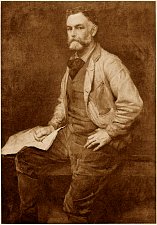 pitsbergen
as a tourist with his family in the summer of 1901. He observed coal
exploration in Bellsund and spent some time ashore in Adventfjord where
he saw outcrops of coal. His interest piqued, he made a second trip and
obtained coal samples that proved to be of high quality. Longyear and an
associate, Frederick Ayer of Boston, purchased the tracts from
Trondhjem-Spitsbergen Kulkompagni on January 1, 1905 for 50,000
Kroner in fully paid shares and 10,000 Kroner cash. Development started
in 1905 and the first company building was constructed in 1906 by Wm. D.
Munroe, who found and acquired additional promising tracts at
Sassenfjord and Kapp Boheman. pitsbergen
as a tourist with his family in the summer of 1901. He observed coal
exploration in Bellsund and spent some time ashore in Adventfjord where
he saw outcrops of coal. His interest piqued, he made a second trip and
obtained coal samples that proved to be of high quality. Longyear and an
associate, Frederick Ayer of Boston, purchased the tracts from
Trondhjem-Spitsbergen Kulkompagni on January 1, 1905 for 50,000
Kroner in fully paid shares and 10,000 Kroner cash. Development started
in 1905 and the first company building was constructed in 1906 by Wm. D.
Munroe, who found and acquired additional promising tracts at
Sassenfjord and Kapp Boheman.
Arctic Coal Company was
incorporated in Boston on February 6, 1906. The following areas
were claimed by the company.
Tract 1: Advent Bay tract -
area from Colesbukta (bukta = bay) to Adventfjord. Mine No.1 was opened
in the winter of 1906/07 in this tract in Longyeardal (dal = valley).
Tract 2: Green-Harbour tract - area from Grønfjord to Colesbukta
Tract 3:
Sassen Bay tract - area from De Geerdal to Sassendal
Tract 4:
Cape Boheman tract - area on Bohemanneset
Serious construction began in the
summer of 1906, sailing June 4th with supplies and 50 workers from
Trondhjem. July 6, 1907 the first load of coal went over the new docks,
becoming the terminus of an aerial ropeway, stock pile and loading
plant. By 1911 there were about 10 buildings at Longyearbyen. On October
1, 1911 the last boat left Adventfjord, leaving a winter force of
90 plus a foreman. Up to 300 people lived in Longyearbyen during the
activities of the Arctic Coal Co., mostly Norwegians.
About 1960 a booklet of coupons
from 1911 was found during a clean-up in the basement of the former
Arctic Coal Co. office building. These scrip, #7489F,
are labeled
Island Creek Stores Company and are believed to have been used at
their supply storeThe Arctic Coal Co. proved commercial coal
production on Svalbard was feasible and profitable. However, the lack of
sovereignty created problems of claim jumping and land disputes. For
example, on Rusanovodde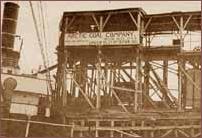 n
(odden = point), Coles Bay Point, in 1913 they found a new Russian
building of heavy plank, Russian flag on pole, two men planning to stay
the winter and 300 ft. from the house an Arctic Coal Co. claim
post, put there in 1905, broken and burned. Also, a number of
individuals and companies were contesting their claims on the east shore
of Grønfjord. In addition, trappers and prospectors would become caught
by ice on Svalbard, experience an accident or run out of supplies, then
sought shelter, help and supplies from the company. These became a
constant problem and burden to the company because they were seldom
repaid and were unable to obtain legal settlements. In addition, world
tensions were leading to war and there were uncertainties in the
economy. Because of these factors Ayer & Longyear decided to sell their
Spitsbergen business. n
(odden = point), Coles Bay Point, in 1913 they found a new Russian
building of heavy plank, Russian flag on pole, two men planning to stay
the winter and 300 ft. from the house an Arctic Coal Co. claim
post, put there in 1905, broken and burned. Also, a number of
individuals and companies were contesting their claims on the east shore
of Grønfjord. In addition, trappers and prospectors would become caught
by ice on Svalbard, experience an accident or run out of supplies, then
sought shelter, help and supplies from the company. These became a
constant problem and burden to the company because they were seldom
repaid and were unable to obtain legal settlements. In addition, world
tensions were leading to war and there were uncertainties in the
economy. Because of these factors Ayer & Longyear decided to sell their
Spitsbergen business.
|
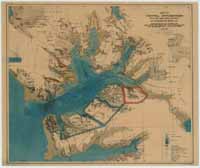
The company shut down in
the autumn of 1915. During the American period 160,000 metric tons
of coal were produced and shipped to Norway. The
Russian-Siberian Company was very interested in purchasing the
Arctic Coal Company along with other Russian, German,
Norwegian, and Swedish companies. F. Hiorth, C. Anker, and others
were encouraging Norwegian interests to purchase the American
company. It resulted in the government sending Adolf Hoel and
Svalheim, geologists and mining experts to Isfjord to investigate.
Their favorable report of September 1915 led to the Norwegian
government exerting pressure on the Central Bank, whose president,
Kjelland-Torkildsen, signed an offer in March of 1916 that
resulted in the purchase of the Arctic Coal Company.
The coupons shown here
are the first of two types known with the first being from the
1911 period. The 1911 booklet shown above is the only example know
to have survived of this issue. The booklet is organized as
follows:
|
Page |
FRONT COVER |
| 1 |
Missing
page
(receipt for book?) |
|
2 |
50¢ x 5 =
|
250¢ |
|
3 |
25¢ x 5 =
|
125¢ |
|
4 |
25¢ x 5 = |
125¢ |
| 5 |
25¢ x 5 = |
125¢ |
| 6 |
25¢ x 5 = |
125¢ |
| 7 |
10¢ x 5 = |
50¢ |
| 8 |
10¢ x 5 = |
50¢ |
| 9 |
5¢ x 5 = |
25¢ |
| 10 |
5¢ x 5 = |
25¢ |
| 11 |
5¢ x 5 = |
25¢ |
| 12 |
5¢ x 5 = |
25¢ |
| 13 |
2¢ x 5 = |
10¢ |
| 14 |
2¢ x 5 = |
10¢ |
| 15 |
2¢ x 5 = |
10¢ |
| 16 |
1¢ x 5 = |
5¢ |
| 17 |
1¢ x 5 = |
5¢ |
| 18 |
1¢ x 5 = |
5¢ |
| 19 |
1¢ x 5 = |
5¢ |
| 20 |
Accounting sheet |
| 21 |
Accounting sheet |
| 22 |
BACK COVER |
The second type of booklet is listed on
Page IC7 |
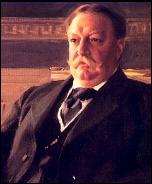

.jpg)
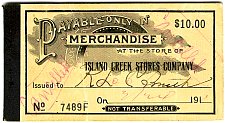
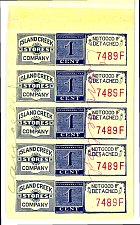

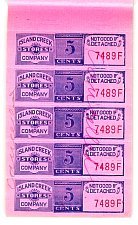
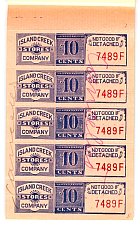
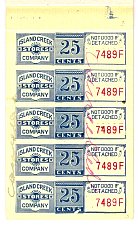
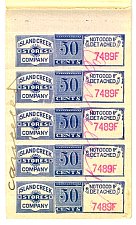
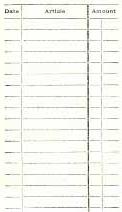
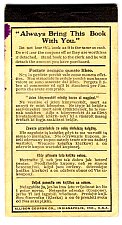
![]()
![]()